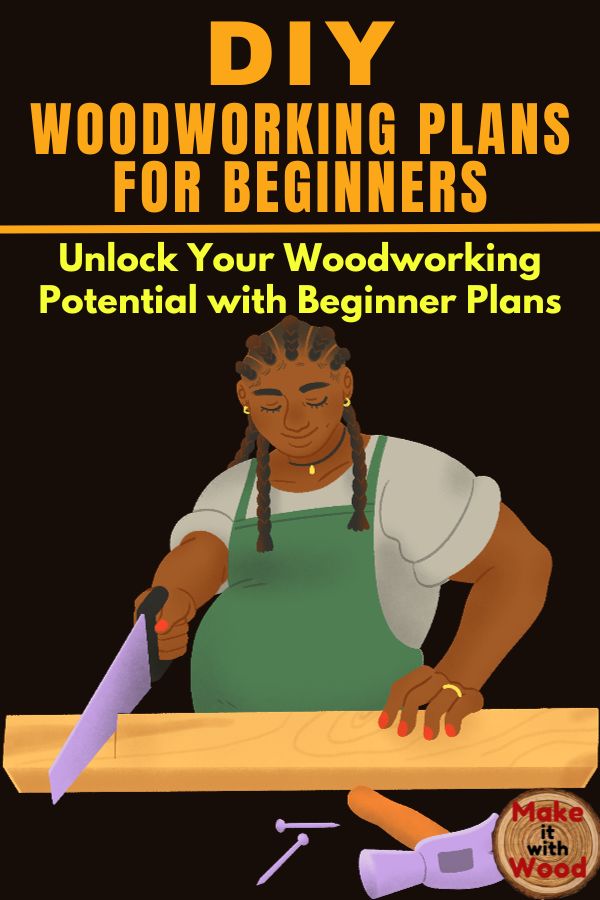DIY woodworking plans for beginners:
Unlock Your Woodworking Potential with Beginner Plans

DIY woodworking plans for beginners
Introduction to Woodworking
Woodworking is a timeless craft that allows for creativity, self-expression, and the satisfaction of creating something with your own hands. Whether you’re a complete novice or have some experience with woodworking, it’s a hobby that can bring immense joy and fulfillment.
The Timeless Craft of Woodworking
Woodworking has been practiced for centuries, with its roots dating back to ancient civilizations. The art of shaping wood into functional and beautiful objects has stood the test of time, evolving and adapting to modern techniques and tools. From furniture making to intricate carvings, woodworking offers endless possibilities for creativity.
Why Woodworking is Worth Exploring
There are many reasons why woodworking is worth exploring as a hobby. Firstly, it allows you to create practical and functional pieces for your home. Need a new shelf or a coffee table? You can make it yourself! Woodworking also serves as a therapeutic outlet, providing a sense of calm and focus as you work with your hands. Moreover, it offers the opportunity to learn new skills and grow as a craftsman.
Tools and Materials You’ll Need to Get Started
Before you embark on your woodworking journey, it’s important to gather the essential tools and materials. Some basic tools you’ll need include a saw, chisels, a mallet, a measuring tape, and clamps. As for materials, you can start with softwoods like pine and progress to hardwoods like oak or maple as you gain more experience. Safety equipment such as goggles, gloves, and a dust mask should also be a priority to ensure a safe woodworking environment.
Understanding Beginner Woodworking Plans
What are DIY Woodworking Plans for Beginners and Why They Matter?
Beginner woodworking plans are blueprints or guides that provide step-by-step instructions for crafting a specific woodwork project. These plans outline the materials, tools, and techniques required to complete a project successfully. They are designed specifically for those who are new to woodworking to help them develop foundational skills while creating something functional or decorative.
Definition and Purpose of Beginner Woodworking Plans
The purpose of beginner woodworking plans is to provide beginners with a structured approach to woodworking. These plans clearly outline the necessary steps, measurements, and techniques needed to complete a project successfully. They act as a road map, guiding beginners through the process and ensuring that they gain confidence and skills along the way.
Benefits of Following Beginner Plans for Novice Woodworkers
Following beginner woodworking plans offers several benefits for novice woodworkers.
Firstly, it provides a clear and organized approach, eliminating guesswork and reducing the chances of errors. It also helps beginners learn and understand fundamental woodworking techniques and concepts, such as measuring, cutting, and joining pieces of wood.
Additionally, beginner plans introduce beginners to different tools, helping them become familiar with their usage and purpose.
How Beginner Plans Help You Build Confidence
Woodworking can feel intimidating for beginners, but following beginner plans can significantly boost confidence. As beginners successfully complete projects following these plans, they gain a sense of accomplishment and realize that woodworking is not as challenging as it may seem. By breaking down larger projects into manageable steps, beginner plans make woodworking more approachable and build confidence in beginners’ abilities.
Types of Beginner Woodworking Plans
There are various types of beginner woodworking plans that cater to different interests and skill levels. Here are some popular categories:
Furniture Projects
Furniture projects are a great starting point for beginner woodworkers. They allow beginners to create functional and aesthetically pleasing pieces for their homes. Crafting tables, chairs, and shelves are commonly featured in beginner plans. These plans guide beginners through the entire process, from selecting the right wood to assembling the finished product.
a. Crafting tables, chairs, and shelves
Tables, chairs, and shelves are essential furniture pieces that beginners can create.
Beginner plans for these projects typically start with simple designs and gradually introduce more advanced techniques. This allows beginners to gain proficiency in basic joinery techniques like butt joints and pocket holes.
b. Understanding the different styles and designs
As beginners progress, they can explore different furniture styles and designs. Beginner plans often include variations of traditional, modern, or rustic styles, allowing beginners to experiment with different aesthetics. This helps in developing an understanding of design principles and personal preferences.
c. Simple joinery techniques for beginners
Joinery techniques are an integral part of woodworking. Beginner woodworking plans focus on simple joinery techniques like dowel joints, dado joints, and miter joints. These techniques are not only beginner-friendly but also lay the foundation for more complex joinery methods in advanced woodworking projects.
Storage Solutions
Building storage units is another popular category in beginner woodworking plans. These projects help beginners enhance their organizational skills while creating functional pieces for their homes.
a. Building cabinets, wardrobes, and organizers
Beginner plans for storage solutions often include projects for cabinets, wardrobes, and organizers. These plans guide beginners through designing and constructing storage units that maximize space and enhance functionality.
b. Maximizing space and functionality
One of the key aspects of crafting storage solutions is maximizing space and functionality.
Beginner plans provide insights and techniques for utilizing space efficiently, such as incorporating shelves, drawers, or compartments.
c. Essential skills for crafting storage units
Creating storage units requires specific skills like accurate measuring, precise cutting, and proper assembly techniques. Beginner plans for storage solutions focus on imparting these essential skills, ensuring that beginners learn the necessary techniques to successfully complete their projects.
Decorative Items and Accessories
For those looking to add a touch of personality to their homes, crafting decorative items and accessories is a popular choice. Beginner plans in this category allow beginners to explore their artistic side while honing their woodworking skills.
a. Creating home decor pieces
Home decor pieces include items like picture frames, wall art, and small sculptures.
Beginner plans for home decor projects provide instructions on carving, shaping, and finishing techniques, allowing beginners to create visually appealing and unique pieces.
b. Perfecting carving and shaping techniques
Carving and shaping wood require precision and attention to detail. Beginner plans offer guidance on using carving tools and techniques, helping beginners develop the skills needed to create intricate designs and fine details.
c. Adding intricate details to enhance aesthetics
Decorative woodworking often involves adding intricate details, such as ornate engravings or
inlays. Beginner plans introduce beginners to these techniques, teaching them how to enhance the aesthetics of their projects through detailed craftsmanship.
Finding and Choosing the Right Beginner Plans
When it comes to finding and choosing beginner woodworking plans, there are a few factors to consider.
Here’s how you can navigate the process:
Exploring Woodworking Resources and Communities
The woodworking community is a treasure trove of resources and support for beginners.
Online platforms and forums dedicated to woodworking enthusiasts provide a wealth of information, ideas, and advice. Engage with these communities to gain insights, discover new plans, and learn from experienced woodworkers.
Locating trusted sources for free or affordable beginner plans
The internet offers countless sources for woodworking plans, but it’s important to ensure their reliability and quality. Look for reputable websites, woodworking magazines, or books that provide free or affordable beginner plans. Verify the credibility of the sources by checking reviews or recommendations from fellow woodworkers.
Recommendations and reviews from experienced woodworkers
Seek recommendations and reviews from experienced woodworkers regarding beginner plans they have used. Their insights can help you narrow down your choices and find plans that align with your skill level and interests. Learning from their experiences can save you time and potential frustrations.
Evaluating Beginner Plans for Your Skill Level
Choosing the right beginner plans is crucial for a successful woodworking journey. Consider the following factors when evaluating plans for your skill level:
Assessing complexity and required tools
Take into account the complexity of the project and ensure you have the necessary tools to complete it. Beginners should start with projects that are within their skill level and gradually challenging themselves as they gain experience and acquire more tools.
Matching your skill level with the plan’s difficulty
Consider your current skill level and choose plans that align with your abilities. Starting with plans that are too advanced may lead to frustration and discourage you from pursuing woodworking further. Find plans that provide a feasible challenge while also allowing room for growth.
Considering time commitment and available resources
Evaluate the time commitment required for a specific project and ensure you have the availability to complete it. Also, consider the resources needed, such as the type and quantity of wood, as well as any additional materials like screws or adhesives. It’s important to choose plans that fit well within your time constraints and available resources.
Adapting and Customizing Beginner Plans
One of the great aspects of woodworking is the ability to adapt and customize plans to suit your specific needs and preferences. Here are some tips for customizing beginner plans:
Tailoring plans to fit your specific needs
Beginner plans can act as a framework that you can modify to fit your desired dimensions, style, or functionality. You can adjust measurements, change materials, or add personalized elements to make the project uniquely yours.
Incorporating personal design elements
Add your personal touch to the plans by incorporating your own design elements or details.
This allows you to infuse your creativity and make the project truly reflect your style and taste.
How to safely modify plans without compromising integrity
When modifying plans, it’s crucial to ensure that the structural integrity of the project is not compromised. Consider consulting experienced woodworkers or referring to woodworking resources for guidance on making safe modifications. Understanding woodworking principles and techniques will help you make informed decisions while customizing plans.
Step-by-Step Execution of Beginner Plans
Once you have chosen a beginner plan, it’s time to dive into the woodworking process. The step-by-step execution of beginner plans involves understanding instructions, mastering woodworking techniques, and troubleshooting common challenges.
Understanding Plan Instructions and Terminology
Beginner plans come with detailed instructions, drawings, and measurements. Here are some tips
to help you understand plan instructions and terminology:
Decoding woodworking jargon for beginners
Woodworking jargon can be overwhelming for beginners. Take the time to familiarize yourself with common woodworking terms and their meanings. Online glossaries or woodworking guides can provide a comprehensive list of jargon and their explanations.
Interpreting plan drawings and measurements
Plan drawings and measurements provide visual cues for the project. Learn how to interpret plan drawings, such as elevations, cross-sections, or exploded views. Understand the importance of accurate measurements and using tools like a square or tape measure correctly.
Identifying common woodworking terms and techniques
While executing the plan, you may come across specific techniques or terms mentioned.
Make sure to understand their significance and how they apply to your project. Research and practice these techniques to improve your woodworking skills.
Essential Woodworking Techniques for Beginners
Mastering the fundamental woodworking techniques is crucial for successfully executing beginner plans. Here are some essential techniques for beginners to focus on:
Introduction to basic woodworking tools and their usage
Start by familiarizing yourself with basic woodworking tools such as the saw, chisels, and planes. Learn how to safely handle and use these tools to perform tasks like cutting, shaping, and smoothing wood.
Mastering fundamental woodworking techniques
Some fundamental woodworking techniques include marking and measuring, making accurate cuts, and shaping wood using hand tools or power tools. Practice these techniques through small projects or exercises to build proficiency and confidence.
Safety guidelines and precautions during woodworking
Safety should always be a top priority in woodworking. Learn and adhere to safety guidelines such as wearing appropriate protective gear, using tools correctly, and maintaining a tidy and organized workspace. Understand the inherent risks associated with woodworking and take the necessary precautions to prevent accidents.
Troubleshooting and Problem-Solving in Woodworking
Even with careful planning and execution, woodworking projects can encounter challenges.
Here are some tips for troubleshooting and problem-solving:
Common challenges faced by beginner woodworkers
Beginner woodworkers often face challenges such as misaligned joints, uneven surfaces, or issues with finishing techniques. Recognize these common challenges as learning opportunities and approach them with a problem-solving mindset.
Tips for overcoming mistakes and setbacks
Mistakes are a natural part of the learning process. When faced with setbacks or errors, take a step back, reassess the situation, and determine the best course of action. Seek guidance from experienced woodworkers, consult online resources, or experiment with different techniques to overcome obstacles.
Seeking guidance and support when encountering difficulties
Don’t hesitate to reach out for help when encountering difficulties. Join woodworking communities, seek advice from experienced woodworkers, or participate in workshops or classes. Learning from the experiences of others can provide invaluable insights and assistance.
Read also
Exploring these easy DIY woodworking plans for beginners
14 Easy Beginner Woodworking Projects with FREE Plans
Summary and FAQs
Recap of the Benefits and Importance of Beginner Woodworking Plans
Beginner woodworking plans provide a structured and supportive approach for novice woodworkers to embark on their woodworking journey. These plans offer clear instructions, develop foundational skills and instill confidence in beginners. They also introduce beginners to various woodworking techniques, tools, and applications, fostering creativity and growth.
Frequently Asked Questions about Getting Started with Beginner Plans
Can I tackle beginner woodworking projects without prior experience?
Absolutely! Beginner woodworking plans are specifically designed to guide and support those with little to no prior experience in woodworking. They provide step-by-step instructions, helping beginners develop skills and understanding of the craft.
How long does it take to complete a beginner woodworking plan?
The time required to complete a beginner woodworking plan varies depending on the complexity of the project and the individual’s skill level. Some projects can be completed in a few hours or days, while others may take weeks. It’s important to be patient and enjoy the process of creating something with your own hands.
What safety measures should I adhere to while working with wood?
Safety should always be a priority in woodworking. Adhere to safety guidelines such as wearing protective gear, using tools correctly, and maintaining a clean and organized workspace. Familiarize yourself with the specific safety precautions for each tool and technique you use.
Are there any alternatives to traditional woodworking tools?
While traditional woodworking tools are preferred and widely used, there are alternative tools available. For example, power tools can provide efficiency and precision, while hand tools can offer a more tactile and hands-on experience. Explore various tool options and choose the ones that suit your preferences and project requirements.
How can I progress from beginner plans to more advanced projects?
As you gain proficiency and confidence through beginner plans, you can gradually progress to more advanced projects. Challenge yourself with projects that incorporate new techniques or design elements. Continuously seek opportunities to learn and expand your skills by attending workshops, experimenting with different materials, and exploring advanced woodworking resources.



